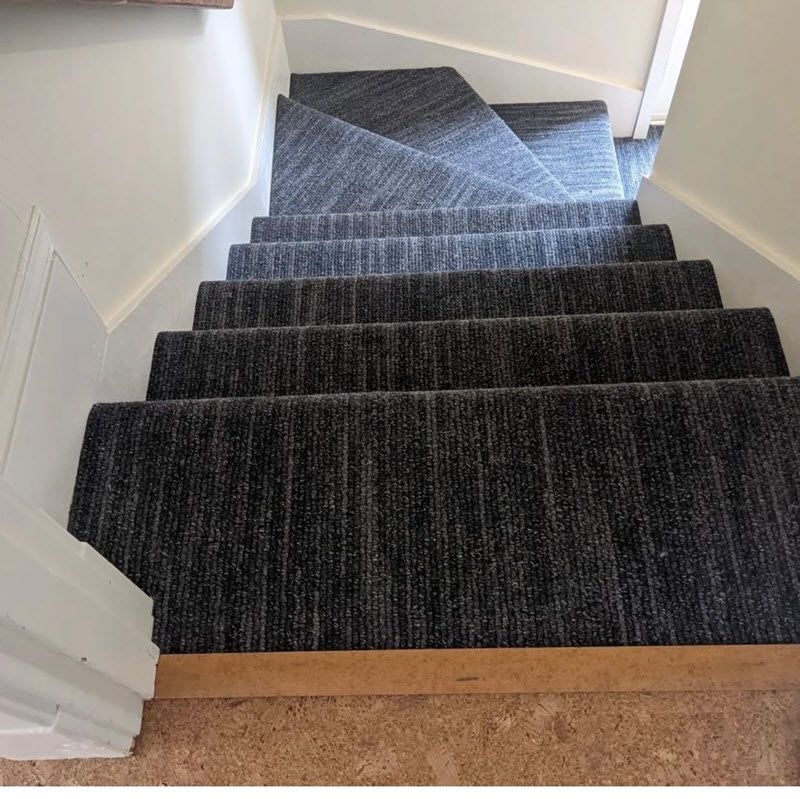Stairs deserve custom runners. Not only do they perform a vital function in your house – connecting one level to another – but stairs also have high visibility, get lots of wear & tear, and tend to be situated in spaces that are unlike any others. In other words, stair runners are unique to your home and, as such, are best customized to your staircase.
We’ll explain further in this article.
What Goes Into Creating Custom Stair Runners?
The installation detailed in this article includes a rectangular-shaped landing with stairs leading up to it and up from it to the next level.
The homeowner chose a dramatic plaid pattern that accentuates the directionality of the staircase. This 15′-wide hand-loomed carpet, Vineyard Plaid in color ebony by Crescent Carpet, featured an 8.5″ x 10″ pattern repeat. It was finished with a hand-applied cotton piping-style black binding.
Step 1 – Carefully Measure the Stairway and Landing
The first step is measuring your stairs and confirming the width and depth of your steps, how many, and what the layout is of your staircase.
Step 2 – Create a Stair Runner Mockup
Mockups are a good idea for any kind of installation where you want to visualize the end result. For custom stair runners, tape helps you ‘see’ so you can determine the ideal width for your runner given that specific staircase’s characteristics.
Note that a major advantage of a custom stair runner is that you get to decide what carpet width you prefer for your stairs. Although you can go with pre-made runners, those offer you very little choice when it comes to width. They also severely limit you when it comes to landings and pie-shaped stairs.
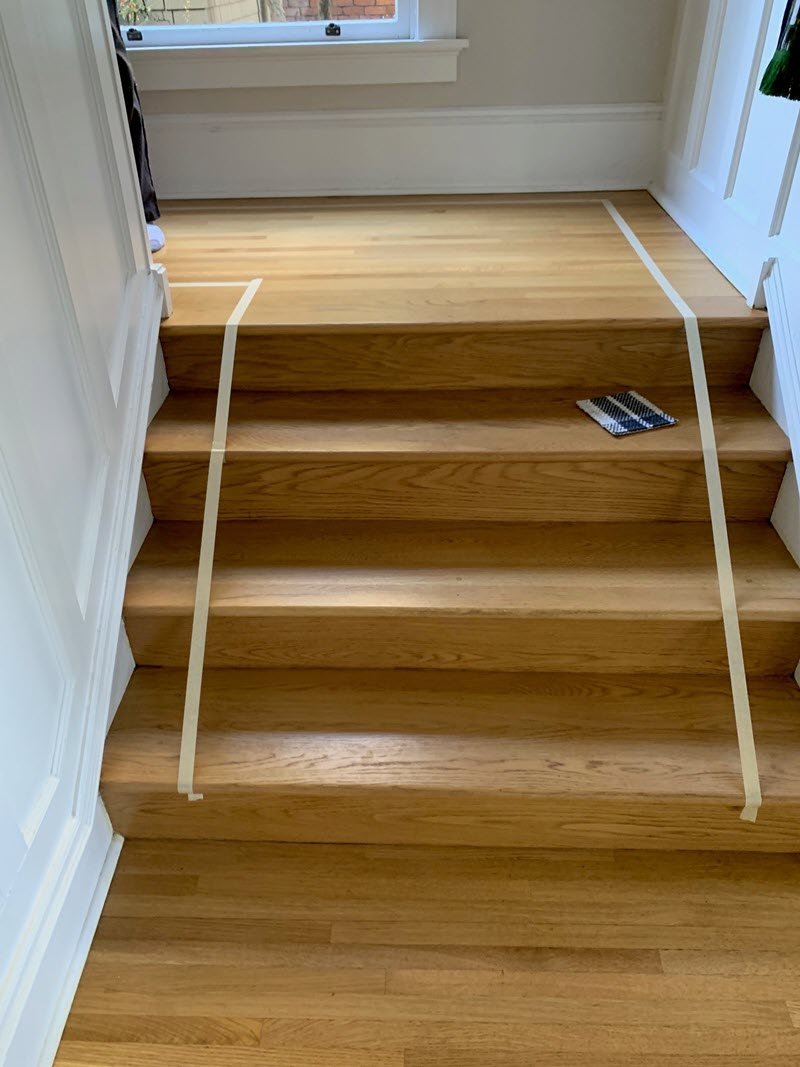
On average, you’ll want to have 5-6″ of wood showing on either side of the runner. That depends on the proportions of your stairs and how your stairs are constructed. You’ll want the runner to feel generous while showing just enough wood.
Step 3 – Carefully Measure Out Runner Dimensions on the Carpet
With the measurements in hand, your carpet professional can lay out those dimensions onto the actual carpet. Notice in the image below the deliberate placement of the blue tape so as to have the same pattern effect on either side of the runner.
Depending on the size of your pattern repeat, this is where you may need additional yardage to match patterns.

Step 4 – Create the Carpet Runner
Next, once cut, your custom runner can be bound with one of these methods:
- Hand-applied cotton binding resembles piping with hidden stitching
- Serging around the edge of the carpet in a contrasting or coordinating color.
- Fabric binding.
Step 5 – Install the Custom Carpet Runner
Installing your custom carpet runner is exciting! Your flooring professional will recommend a carpet pad to add dimensional stability and protect the runner from wear and tear. The end result will look elegantly perfect for your space.
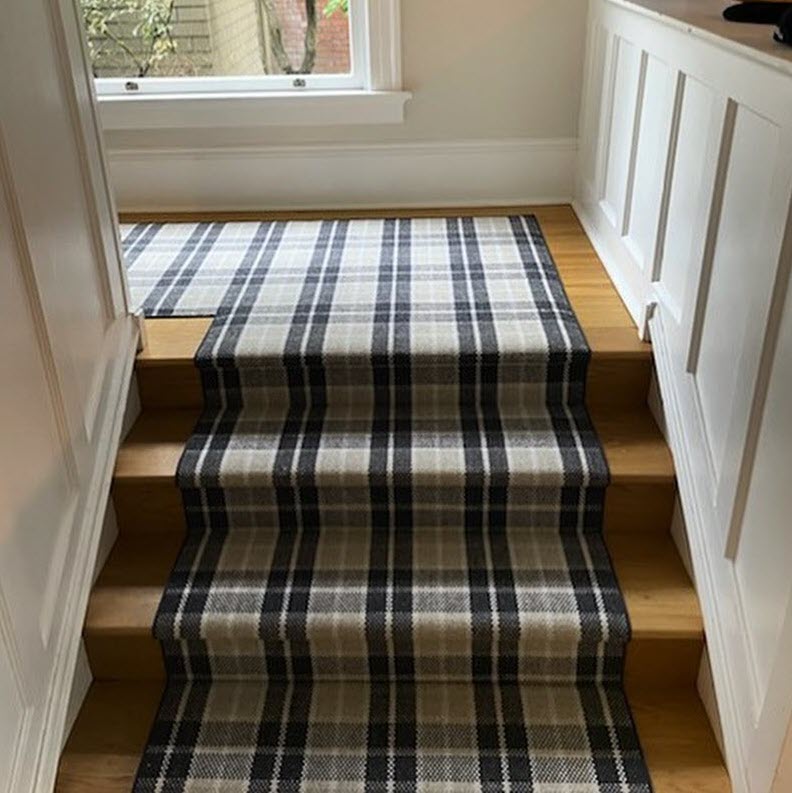
Other Custom Stair Runner Decisions
You may encounter a few other decisions as you finalize your custom stair runner.
Refinishing the Staircase
If your staircase is in poor shape, you’ll want to have it spruced up. That may entail painting or a more extreme refinishing process. Your flooring professional will walk through the possibilities with you so you feel comfortable with your decision.
In some cases – as with the staircase below – the stairs are so beaten up that the best solution is to install the carpet wall-to-wall rather than as a true runner. These stairs are in an old Craftsman-style house converted into a commercial business space.
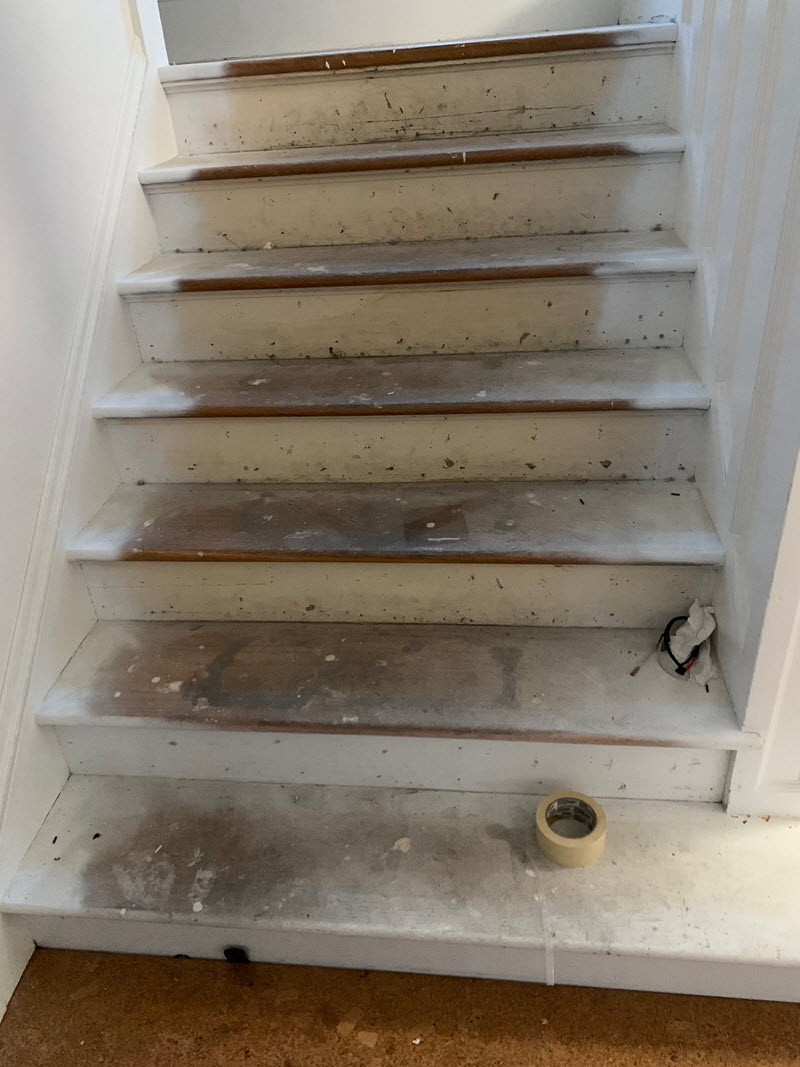
The staircase also includes a pie-shaped landing with cork floors at the top and bottom of the stairs.
Deciding What Kind of Custom Stair Runner Installation You Prefer
Stair runners can be installed in one of two ways:
- Colonial wrap
- Upholstered wrap
A third option isn’t exactly a runner but rather a wall-to-wall installation as you see in the image above.
Colonial Stair Runner Installation
In a colonial wrap, the carpet wraps around the lip of each step, outlining it. It is then attached to the riser immediately below the lip.
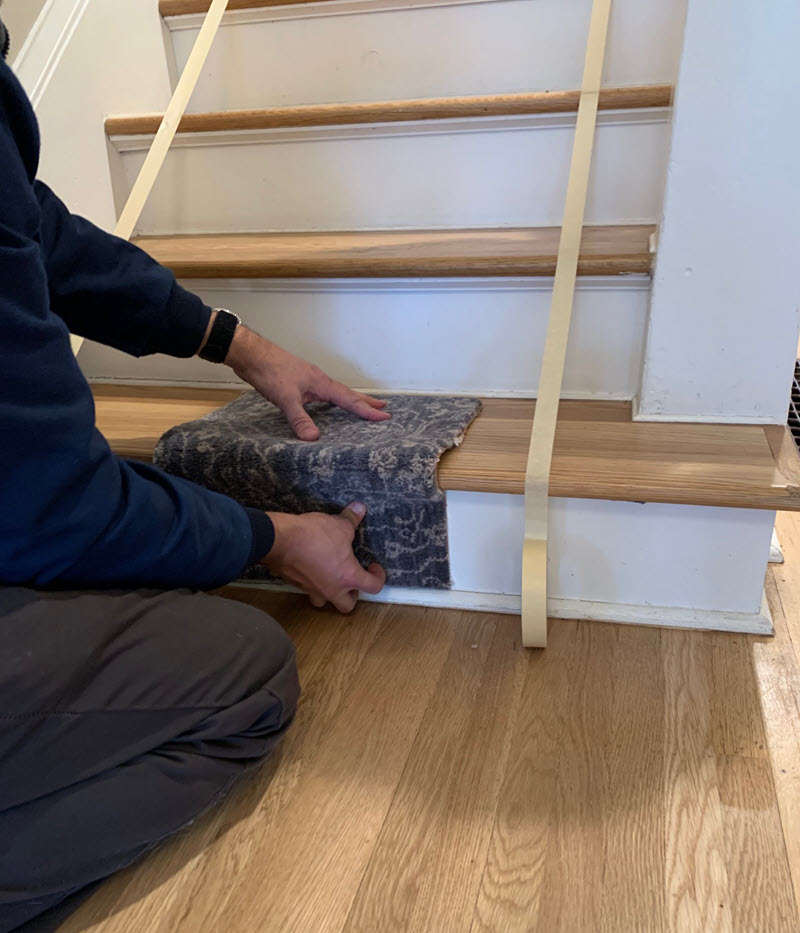
Here’s how that stair runner installation looks.
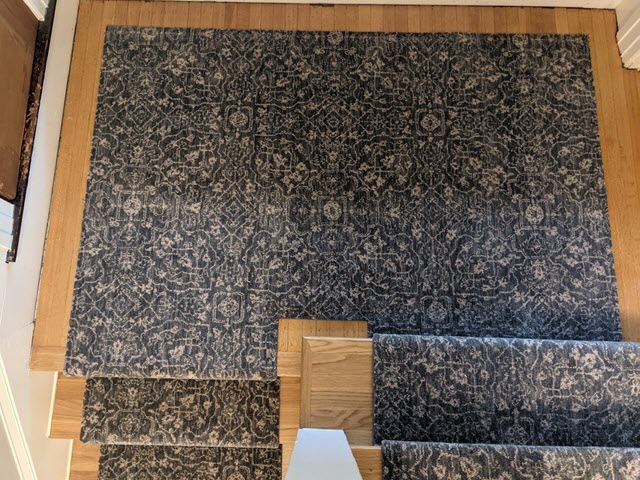
Here is another example of a colonial wrap with a non-patterned carpet.
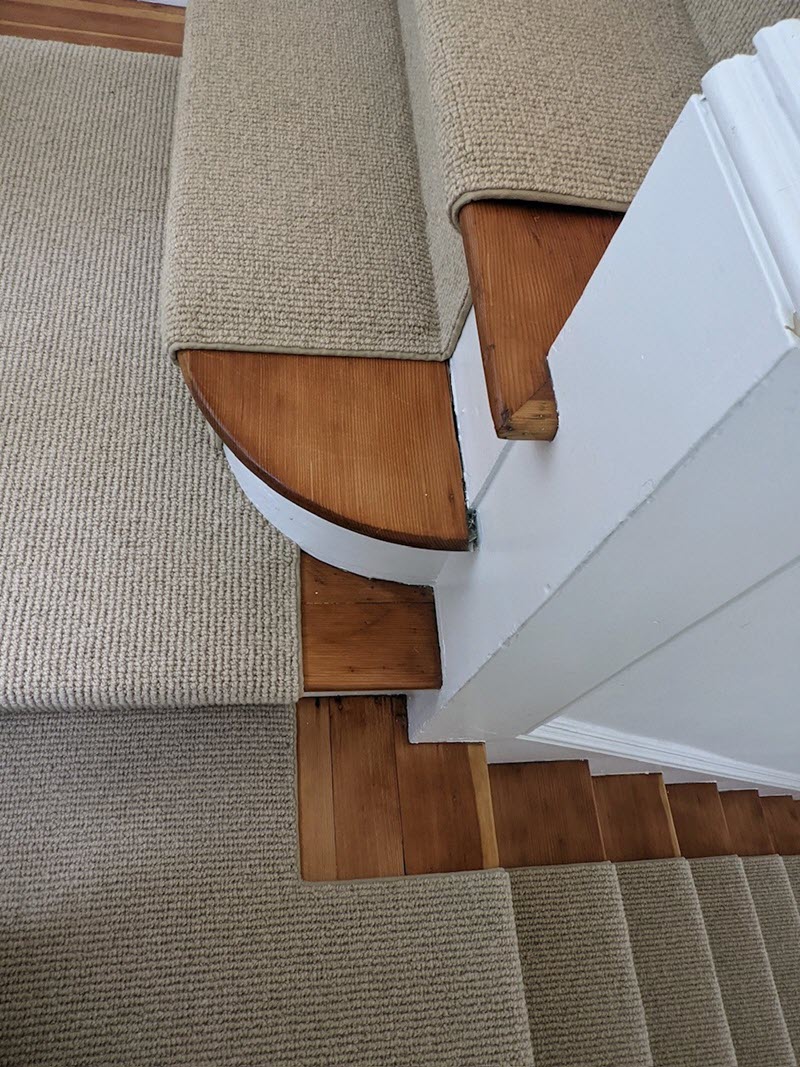
Waterfall Installation
In a waterfall installation, the carpet ‘falls’ from one step down to the next as you see in the image below.
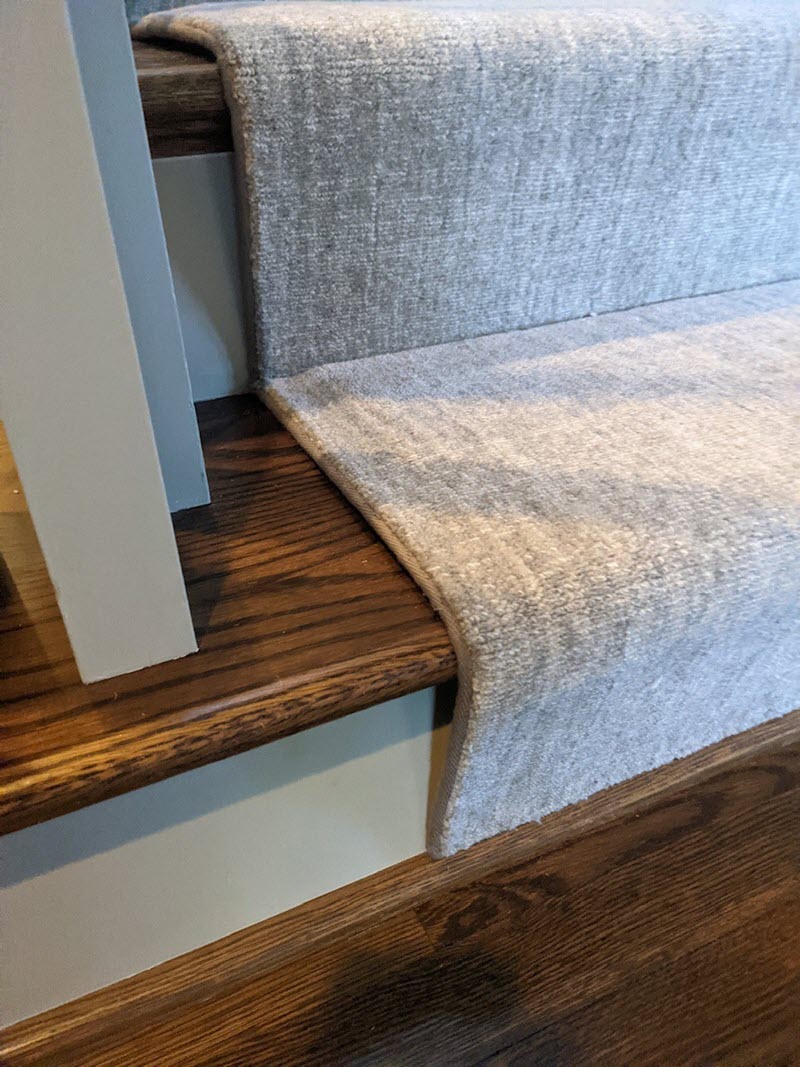
Are You Ready to Explore Custom Stair Runners Firsthand?
If and when you’re ready, we invite you to visit the Classique Floors + Tile showroom in Portland where you can see a beautiful assortment of carpet patterns firsthand, any of which could work for your stairs.
By the way, we’re assuming that you agree that carpet is an ideal choice for stairways. As we explain on the carpet runner page, carpet offers you:
1 – Safety
Bare stairs can be very slippery especially if you are wearing socks. They can be challenging for pets to easily go up and down; dogs in particular have a hard time with steps. For children and adults alike, uncarpeted stairs can be dangerous. Carpet cushions any falls and offers more traction.
2 – Sound Abatement
For many people though, the non-stop click/clack of traffic up and down a staircase can be distracting and plain noisy. The solution? Carpet because it muffles sound.
3 – Add Style and Beauty to Your Stairs
As a textile, carpet offers you limitless options in terms of colors, patterns, and textures to add to your home. Add drama, subtlety, touches of color, and interesting patterns – it’s all possible. With carpet, you can integrate your staircase into the rest of your home’s design scheme.
4 – Texture Underfoot
Carpet offers your feet delicious texture and warmth on those chilly days when you’re barefoot. And, on hot days, you can rest assured that your feet won’t stick to the surface as they might on hardwood or another hard surface.
We look forward to helping you and answering any questions you have about the pros and cons of custom stair runners and which carpet would work best for your lifestyle.
Thanks for reading!
VISIT OUR SHOWROOM: WALK-INS ARE WELCOME!
What Goes Into Creating Custom Stair Runners? in Portland OR
Serving the Portland Metro Area and beyond
